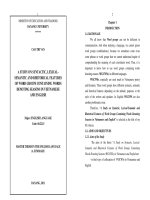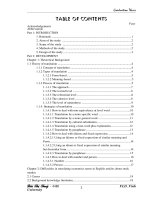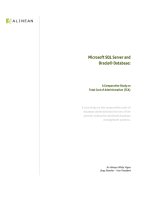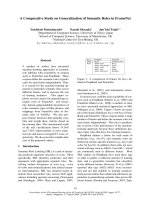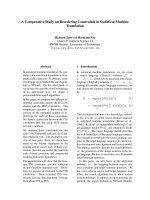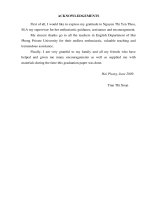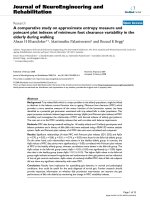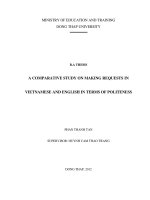A COMPARATIVE STUDY ON MEANINGS OF WATER RELATING IDIOMS IN VIETNAMESE AND ENGLISH Nghiên cứu so sánh về nghĩa của các thành ngữ có liên quan đến nước trong tiếng Việt và tiếng Anh
Bạn đang xem bản rút gọn của tài liệu. Xem và tải ngay bản đầy đủ của tài liệu tại đây (1.16 MB, 62 trang )
VIETNAM NATIONAL UNIVERSITY, HANOI
UNIVERSITY OF LANGUAGES AND INTERNATIONAL STUDIES
FACULTY OF POST- GRADUATE STUDIES
TRẦN THỊ HƢƠNG
A COMPARATIVE STUDY ON MEANINGS OF WATER
RELATING IDIOMS IN VIETNAMESE AND ENGLISH
(Nghiên cứu so sánh về nghĩa của các thành ngữ có liên
quan đến nƣớc trong Tiếng Việt và Tiếng Anh)
M.A. MINOR PROGRAMME THESIS
Field: English Linguistics
Code: 60220201
Hanoi, 2014
VIETNAM NATIONAL UNIVERSITY, HANOI
UNIVERSITY OF LANGUAGES AND INTERNATIONAL STUDIES
FACULTY OF POST- GRADUATE STUDIES
TRẦN THỊ HƢƠNG
A COMPARATIVE STUDY ON MEANINGS OF WATER
RELATING IDIOMS IN VIETNAMESE AND ENGLISH
(Nghiên cứu so sánh về nghĩa của các thành ngữ có liên
quan đến nƣớc trong Tiếng Việt và Tiếng Anh)
M.A. MINOR PROGRAMME THESIS
Field: English Linguistics
Code: 60220201
Supervisor: Dr. Ngô Tự Lập
Hanoi, 2014
i
DECLARATION
I, Trần Thị Hương, hereby declare that the work contained in this thesis
is the result of my own research. It is recognized that, should this declaration
be found to be false, disciplinary action could be taken and penalties imposed
in accordance with the University policy and rules.
Ha noi, 2014
Trần Thị Hương
ii
ACKNOWLEDGEMENTS
I offer my sincere gratitude to the faculty, staff and my fellow students
at Hai Duong College, who have inspired me to continue my work in this
field. I owe particular thanks to my Thesis Supervisor, Dr. Ngô Tự Lập and
his colleagues of the faculty of Post-Graduate Studies, University of
Languages and International Studies, Viet Nam National University, Ha Noi,
all of whom have had an impact on my work in one way or another. The
direction and support of a knowledgeable and diverse group, such as this, is
what makes interdisciplinary endeavours possible.
Finally, my special thanks go to my mother, my husband and my children for
their love and support throughout this project. Without their encouragement I
could not have completed this thesis.
iii
ABSTRACT
Idioms, a special form of language use, are shaped in the daily lives of
people. Idioms can also be considered as a reliable measure of the proficiency
of foreign languages in general and English in particular. It is the semantic
and grammatical problems that cause difficulties for learners to grasp
meanings of idioms. With the aim of providing in - depth information about
English and Vietnamese idioms, we have tried to work out some syntactic and
semantic features of idioms relating to water in English and Vietnamese.
Moreover, some cultural contexts hidden behind these idioms are mentioned
and analyzed in this thesis. The study also puts forwards some implications
for teaching and learning idioms. We believe that they are helpful to teachers
and students as well as translators of English.
iv
TABLE OF CONTENTS
PART A: INTRODUCTION
1. Rationale for the study 1
2. Aims and objectives of the study 1
3. Scope of the study 2
4. Theoretical and practical significance of the study 2
5. Methodology 2
6. Organization of the study 3
PART B: DEVELOPMENT
CHAPTER 1: IDIOMS - THEORETICAL BACKGROUND FOR THE
STUDY
1.1.Idioms and meanings of idioms 4
1.1.1.Definition of idioms 4
1.1.2. Idioms and proverbs 4
1.1.3. Typology of idioms 6
1.1.4. Meaning of idioms 8
1.2.Culture and the relationship between language and culture 9
1.2.1.Culture and some characteristics of culture 9
1.2.2.Relationship between language and culture 10
1.2.3. Culture in idioms 11
1.2.4. The image of water in Vietnamese culture 12
1.2.5. The image of water in English culture 14
v
1.2.6. Previous studies related to the theme of this thesis 15
CHAPTER 2: “WATER” RELATING IDIOMS IN ENGLISH AND
VIETNAMESE
2. 1. A quantitative survey of water relating idioms in English and
Vietnamese 17
2. 2. Syntactic study of water relating idioms in English and Vietnamese 17
2. 3. Semantic study of water relating idioms in English and Vietnamese .21
CHAPTER 3: FINDINGS AND DISCUSSION
3.1. Similarities and differences of English and Vietnamese water relating
idioms in terms of syntactic features 29
3.2. Similarities and differences of English and Vietnamese water relating
idioms in terms of semantic features 31
PART C: CONCLUSION
1.Recapitulation 34
2.Implications 34
3.Limitations and suggestions for further studies 35
1
PART A: INTRODUCTION
1. Rationale for the study
Water is essential for life and for human kind, and it is crucial for
sustainable socio - economic development. As a matter of fact, 22 March of
each year is declared as the World Water Day (WWD) by the United Nations
in December 2003. Water is not only a physical resource but in every cultural
context, it is closely linked to social, spiritual, political and environmental
meanings. Both English and Vietnamese are rich in idiomatic expressions of
which idioms denoting water are abundant. Idiomatic expressions are largely
used in our daily communication conveying the common - sense wisdom and
experience of a certain cultural group. Mass media, textbooks and everyday
language embody rich sources of idiomatic expressions. It is believed that
English idioms are even difficult for English native speakers and naturally
more problematic for ESL/EFL learners because the figurative meanings of
English idioms cannot be predicted through an analysis of their individual
word meanings. Apparently, teaching EFL learners to use English idioms is
considerably critical for EFL teachers. Learning idioms adds a lot to
understand the British culture and people because language is the bearer of
culture, and idioms consistently have their roots in a particular culture. The
purpose of identifying how the image of water is reflected in idioms
metaphorically and literally and what cultural context underlines it urges me
to investigate into the theme: “A comparative study of water relating idioms
in Vietnamese and English”.
2. Aims and objectives of the study
2.1. Aims of the study
This thesis is conducted as an attempt to:
- Explore the English and Vietnamese idioms relating to water with the main
focus on the cultural viewpoint.
- Point out the similarities and differences between the two languages in terms
of idioms relating to water.
2
2.2. Objectives of the study
The objectives of this study are to:
- Investigate English and Vietnamese idioms relating to water.
- Clarify the cultural differences and similarities.
- Provide some suggestions for teaching, learning and translating English
idioms denoting water.
2.3. Research questions
The study tries to answer the following questions:
- What are the general syntactic, semantic and cultural features of
English and Vietnamese water relating idioms?
- What are similarities and differences between English and Vietnamese
water relating idioms from cultural viewpoint?
3. Scope of the study
In this research, both English and Vietnamese idioms relating to water are
discussed in terms of syntactic, semantic and cultural features. All English
and Vietnamese idioms are collected from two dictionaries: “Vietnamese
Dictionary of Idioms and Proverbs” (2010) by Nguyễn Lân and “The Oxford
Dictionary of Idioms” (2004) by Oxford University Press.
4. Theoretical and practical significance of the study
The study is an attempt to look into idioms for the Vietnamese postgraduates
of English. Thus, once completed, its outcome may offer significant benefits
to Vietnamese learners and teachers of English. In addition, the findings of
this study will familiarize Vietnamese teachers of English with meanings of
idioms that their students may use in class and that they might consider as
errors or mistakes. Furthermore, in regard to Vietnamese learners, the
research may provide them with deep and comprehensive insight into water
relating idioms. Last but not least, researchers of the related fields can use this
study for reference and carry out further and deeper investigation.
5. Methodology
In this study, the major methods applied are descriptive, comparative and
contrastive analysis. It is carried out on carefully collected materials from two
3
dictionaries. The first dictionary is “Vietnamese Dictionary of Idioms and
Proverbs” by Nguyễn Lân (Literature Publishing House in 2010). The second
one is “The Oxford Dictionary of Idioms” (Second Edition) by Oxford
University Press in 2004. The data are analyzed and synthesized to find out
the similarities and differences between English and Vietnamese water
relating idioms.
6. Organization of the study
The thesis is divided into three main parts:
- Part One is an Introduction to the study and includes rationale, aims, the
research questions, objectives, scope, significance and the design of the whole
paper.
- Part Two is the Development which is composed of three chapters. Chapter
One, as implied in the title “Idioms: theoretical background for the study”,
presents the theoretical background related to the issue. Chapter Two is
concerned with “Water relating idioms in English and Vietnamese” covers
the syntactic and semantic study of water relating idioms in English and
Vietnamese. Chapter Three deals with “Findings and Discussions” (i.e.
analysis of data, results)
- Part Three is the Conclusion which summarizes significant findings of the
investigation, elaborates contributions of the research, puts forward practical
suggestions for future research as well as addresses notable limitations.
4
PART B: DEVELOPMENT
CHAPTER 1: IDIOMS - THEORETICAL BACKGROUND FOR THE
STUDY
1.1. Idioms and meanings of idioms
1.1.1. Definition of idioms
In the Longman Dictionary of English Language and Culture, idiom
is defined as “a fixed phrase that has its own special meaning. It’s often
impossible to guess the meaning of the whole phrase from the meanings of
the separate words that it is formed from”. The Collins Cobuild Dictionary
of Idioms (2002) explains it as “a special kind of phrase. It is a group of
words which have a different meaning when used together from the one it
would have if the meaning of each word were taken individually. Idioms are
typically metaphorical: they are effectively metaphors which have become
“fixed” or “fossilized”. Martin H. Manser (1997) states in his Dictionary of
Everyday Idioms: “Idioms are fairly fixed phrases that consist of more than
one word, with a meaning that cannot be understood from putting together the
meanings of the individual words”.
From the above given definitions of idioms, it is clear that although
there are some differences among the definitions of idiom, all idioms share 3
main characteristics in common:
Firstly, idioms are basically fixed expressions in terms of words, their
orders, and their grammatical forms. These expressions are phrases of two or
more words and belong to both spoken and written English.
Secondly, the meaning of an idiom is metaphorical rather than literal.
Thirdly, an idiom is more or less invariable and fixed in wording and in
certain grammatical way; it can not be changed or varied whether in speech or
writing.
1.1.2. Idioms and proverbs
It is rather difficult to make distinction between idioms and proverbs.
However, some significant points below help clarify their distinctions clearly.
5
A proverb is a simple and concrete saying, popularly known and
repeated, that expresses a truth based on common sense or the practical
experience of humanity. They are often metaphorical. Oxford Advanced
Learner’s Dictionary gives the definition of a proverb as “a well - known
phrase or sentence that gives advice or says something that is generally true”
(p. 1062). Longman Dictionary of English Language and Culture considers
a proverb as “a short well - known, supposedly wise, saying usually in simple
language” (p. 1058).
An idiom is an expression that can be understood only as a whole and
not by analysing its constituent parts. For example, if you know what “kick”,
“the” and “bucket” mean, that won’t help you understand that “kick the
bucket” means “die”.
Idioms and proverbs share something in common. Firstly, both of them
are fixed expressions that we can not add, omit, or replace any components of
them without making them lose their figurative meanings or become
meaningless. Secondly, the meanings of idioms and proverbs are
metaphorical. That is why we can not look them up in an ordinary dictionary.
Finally, both of them are created through the processes of labour, discovery
and learning. They are the results of human’s thinking, cultures and
experiences.
However, idioms and proverbs have their own typical features.
Specifically, proverbs give advice, make an observation, express the truth
based on a common sense or practicality, present a teaching in a brief and
memorable way. For example, the proverb “Don’t cry over spilled
milk” indicates “Don’t get upset over something that has already been done.
It’s too late to worry about it now, just get on with your life.” Idioms, on the
other hands, function as naming, depicting things, properties or various
phenomena. The idiom “By the skin of your teeth” means that something was
successful, but only just barely. In term of grammatical structures, idioms
often serve as parts of sentences (e.g. “In hot water”, “A keen worker”)
6
whereas, proverbs are complete phrases or sentences that can pass on the
whole idea (e.g. “Spare the rod, spoil the child”).
Not all idioms are proverbs but all proverbs are idioms.
1.1.3. Typology of idioms
“Long man Dictionary of English Idioms” (1979) divides idioms into
8 types:
Traditional idioms: Most of these idioms are full sentences of which only
subjects are added to make full sentences of the verb phrases like “spill the
beans”. Other types of idiomatic expression act as particular parts of speech.
For example, the idiomatic noun phrase the salt of the earth is used as a
complement in the sentence he is the salt of the earth.
Idioms in which actions stand for emotions or feelings: These idioms
mention actions that are culture - specific which create misunderstanding for
beginning learners of English. Consider the idiom throw up one’s hands/
arms in the sentence I threw up my hands when I heard how much money he
heard. The action in this idiom means that the speaker is annoyed, or
impatient, or not glad with what happened. The meaning in these idioms is
often specific in English - speaking countries. These idiomatic expressions
should be carefully learnt and translated.
Pairs of words: These idioms are peculiar parts of speech joined by and or or.
In the sentence It is rainning cats and dogs (= It was raining heavily), the
noun phrase cats and dogs function as an adverb.
Idioms with “it”: It is considered as a fixed part of the idiom. The pronoun
does not refer to a word coming before it as it usually does. The verb phrase
live it up (= to have an exciting and happy time) is an example for this type.
Allusions: These idiomatic expressions have specific meaning in English
society and their meanings are not normally defined in ordinary dictionaries.
For example, Whitehall is not only understood as a place in London but
means “the government” or “the civil service”.
Sayings: These are often complete sentences such as “Blood is thicker than
water” (Family royalties are stronger than other relationships)
7
Typical conversational phrases: The meanings in those conversational
phrases are not literal and difficult to understand, e.g. how do you do, so to
speak, etc.
Similes: These idioms compare a quality, condition, action, etc., with a noun
such as (as) dead as a doornail (= truly dead), (as) easy as pie (= very easy)
Oxford Dictionary of Current Idiomatic English (1971) indicates 4
main types of idioms:
Pure idioms: These idioms are through constant re - use, then undergo
figurative extension and finally fossilize in meanings. They in the strict sense
comprise only one. Two typical examples for this type are blow the gaff (= to
tell sth secret, especially by mistake) and kick the bucket (= die)
Figurative idioms: The literal senses of these idiomatic expressions do not
exist alongside their figurative ones in normal, everyday use. Variation in
these idioms is rarely found and pronoun substitution unlikely, e.g. a narrow
shave (= a situation where something unpleasant or dangerous nearly
happened)
Restricted collocations: These idioms are referred to as semi- idioms and
idiom- like. They are considered as semi- idioms in the case that one word (in
the case of two- word expressions) has a figurative sense not found outside
that limited context. The other element emerges in a familiar, literal sense
(e.g. a blind alley). And some idioms allow a degree of lexical variation (e.g.
a virtue). In other respects, restricted collocations are idiom- like. For
example, chequered is limited to collocations with career and history.
Open collocations: In open collocations, each element is used in a common
literal sense and both elements (verb and object, or adjective and noun) are
freely recombinable, e.g. fill, empty, drain the sink and fill the sink, basin, and
bucket
According to Oxford Dictionary of Current Idiomatic English, idioms
are classified under two general headings- phrase idioms and clause idioms.
The most common clause patterns covered by idioms are the following:
8
Idioms as verb phrase: pour (or throw) cold water on (be discourging or
negative about a plan or suggestion): I really do not want to pour cold water
on your plan but I don’t think it will work
Idioms as noun phrase: a bargain basement (part of a shop where goods are
sold at reduced price): It's not bargain basement but will brighten up a special
room.
Idioms as adjective phrase: like water off a duck’s back (a remark or incident
which has no apparent effect on a person): I didn't care what they talked to
me - it was like water off a duck's back.
Idioms as prepositional phrase: in hot water (in a situation of difficulty,
trouble or disgrace): I found myself in hot water over their comments on my
appearance.
Idioms as adverbial phrase: as never before (in a way that has never
been possible before): He will be under pressure as never before when he tries
to win this match.
It is clear that idioms can take many forms as well as structures. However, the
system of the clause classification seems to be the most effective and useful
for learners of English.
1.1.4. Meaning of idioms
Idioms are expressions mostly used in daily informal speech which often
derive from people’s experience and contain a certain social and cultural
background.
An idiom is a combination of words that have a figurative
meaning owing to its common usage. An idiom's figurative meaning is
separated from the literal meaning. For example, the idiom “An arm and leg”
in the sentence “That jacket costs an arm and a leg” means something is very
expensive, costly. The meaning of an idiom is not the regular sum of the
meanings of its component parts, so idioms are difficult to translate well; in
some cases, when an idiom is translated directly word-for-word into another
language, either its meaning is changed or it becomes meaningless.
9
On the other hand, metaphorical and literal meanings can be easily
found in some idioms. Let us look at examples: “as pretty as picture”, “as
busy as a bee”. One can guess their meanings without any difficulties.
Finally, idioms can pass on positive, negative and neutral meanings.
Idiomatic expressions “Split hairs” (too interested in small or unimportant
details) and “To cry crocodile’s tears” (to pretend) are good examples for
negative meanings of idioms. Some idioms such as “Full of the joys of
spring” (lively and cheerful), “Every cloud has a silver lining” (be optimistic,
even difficult times will lead to better days) are considered as idioms of
positive meanings. Some idioms with neutral meanings are “Gift of the gab”
(the ability to speak well), “At loggerheads” (to differ strongly).
1.2. Culture and the relationship between language and culture
1.2.1. Culture and some characteristics of culture
The word “culture” that hails from the Latin word, “cultura” derived from
“colere” (to cultivate). Samovar & Porter (2003) defines culture as “the
deposit of knowledge, experience, beliefs, values, attitudes, meanings,
hierarchies, religion, notions of time, roles, spatial relations, concepts of the
universe, and material objects and possessions acquired by a group of people
in the course of generations through individual and group striving” (Samovar
& Porter, 2003, p.8).
Levine and Adelman (1993: XVII) considers culture as “a shared background
(for example, national, ethnic, religious) resulting from a common language
and communication style, customs, beliefs, attitudes and values”.
Porter, Samovar and McDaniel (2007: 21-30) submit six features of culture as
follows:
In the first place, culture is learned. We learn unconsciously culture
from families, peers, institutions, and media. We live in a certain group of
people in a society and share certain ideals and shape our lives. The ideals we
base our lives on is a part of culture. Cultural values are transfered from one
generation to another. The language, the literature and the art forms pass
10
across generations. Culture is learned, understood and adopted by the younger
generations of society
Secondly, culture is shared. It is easy for us to act in appropriate ways
as well as predict how others will act as a result of sharing our culture to other
members in our group. Customs, beliefs, traditions, values are all shared by
man in a social situation and adopted by all equally.
Thirdly, culture is transmitted. Culture is capable of transmitted from
one generation to the next. Parents pass cultural traits to their children and in
return they pass to their children and so on. It is transmitted through language.
Language is a means to pass cultural traits on to future generations.
Fourthly, culture is based on symbols. A symbol is something that
stands for something else. Symbols such as gestures, objects, flags or
religious icons vary cross-culturally. They only have meaning when people in
a culture agree on their use. Language is the most important symbolic
component of culture.
Fifthly, culture is integrated. One must learn about all of aspects of a
culture because all of them are related. The development of culture is the
intergration of its various parts. For example, values system is interlinked
with morality, customs, beliefs and religion.
Finally, culture is dynamic. This simply means that cultures interact
and change. Because most cultures are in contact with other cultures, they
exchange ideas and symbols. All cultures change, otherwise, they would have
problems adapting to changing environments. And because cultures are
integrated, if one component in the system changes, it is likely that the entire
system must adjust.
1.2.2. Relationship between language and culture
In his book “Language”, Sapir emphasises that “Languages may
spread far beyond their original home, invading the territory of new races and
11
of new culture spheres. A language may even die out in its primary area and
live on among peoples violently hostile to the persons of its original speakers.
Further, the accidents of history are constantly rearranged the borders of
culture areas without necessary effacing the existing linguistic cleavages
(Sapir, 1921: 208)
According to Fishman (1985, 1991, and 1996), there are three links
between language and culture:
Language as a part of culture
Language as an index of culture
Language as symbols of culture
In his first point of view, language is “an inevitable part”, “a major part” of
culture. He emphasizes that language is a part of its “associated” culture, but
culture is also a part of its “associated” language. To explain for the second
point “language as an index of culture”, he describes “languages reveal the
way of thinking or of organizing experience that are common in the
associated cultures”. In the third point on the relationship between language
and culture, Fishman explains that “language movements and language
conflicts utilize languages as symbols to mobilize populations to defend (or
attack) and to foster (or reject) the cultures associated with them”
1.2.3. Culture in idioms
English is a language rich in idiomatic expressions. The idiom is a kind
of special speech form that is particular in meaning, grammatical structure
and usage. Idioms are shaped after a long period’s living and working of the
local people. As it is said above, it is impossible to explain the idiom from the
literal meaning of the individual words. Using idioms when speaking is a
usual way for the local people to express their ideas clearly and
vividly.Therefore, the differences on geography, history, custom and living
habits result in the word-usage in idioms. Little knowledge about the history
and the culture behind these idioms makes it hard for people to understand
them in a right way. The cultural context occupies a very important position
12
in idioms learning. Learners must understand the specific cultural context of
the idioms, and then they can understand the idioms.
As we all know, language is closely related to culture and can be said
as a part of culture. From a dynamic view, language and culture intermingle
with each other and shape each other. Language is the bearer of culture which
in turn is the content of language. Idioms as a special form of language exist
in both of them and carry a large amount of cultural information such as
history, geography, and religion, custom, nationality psychology, thought
pattern, etc and therefore are closely related to culture. As a result, we can
widen our knowledge of culture through studying idioms and on the other
hand get better understanding of idioms by examining the cultural background
behind them. For example, Vietnam is a large agricultural country with the
great help of buffalos in the fields. It is easy to catch the image of buffalos in
Vietnamese idioms like “Trâu chậm uống nước đục”, whereas with similar
meaning the English people would say “First come, first served” or “The
early bird catches the worm”.
1.2.4. The image of water in Vietnamese culture
Vietnam has a long history. Over 3000 years ago, Vietnamese ancestors
lived inside many limestone caves in the Northeast and Northwest of
Vietnam. These areas were their first home. Time by time, their groups
became so big that there were not enough space and food for them. Finding
new areas for living was urgent. In the end, they decided to move down the
mountains to a delta (the Red River delta at the moment). Available rivers,
lakes, ponds made it easy for them to find lots of fish for food. Besides, flat
topography with full of water is good for planting different crops especially
wet rice. It was also the time Vietnam Water Culture and the Red River
civilization or wet rice civilization being formed. Since then, the Vietnamese
people have learnt how to live with water and succeeded in conquering it,
using it and taking full advantages of it for their life. Water affects their daily
life activities from traffic to livelihood. However, Vietnamese people took the
advantage of water to defend their country. The two famous victories were on
13
Bach Dang river in 938 and 1288 when the Vietnamese fought against Nam
Han and Song (Chinese), won independence and freedom after 1000 year
domination.
Agriculture is an important part in Vietnam’s economic structure even
today. It makes a considerable contribution to export turnover, GDP and
creates the largest amount of jobs, and is the main source of the
poor’s income. Main products of Vietnamese agriculture are rice, coffee, tea,
rubber, sugar and cashew nut. Vietnam is one of the top rice exporting
countries in the world. Natural conditions in Vietnam have some advantages
for agricultural development especially two vast, rich, and flat deltas: Red
River Delta and Mekong River Delta which consequently base the two largest
cities in the country - Hanoi and Ho Chi Minh City. When residents in the
Red River Delta and Mekong Delta start learning to walk, they also begin to
play with water. The childhood memories are imprinted with the sight of
water, bathing in the river or launching paper boats. That is why water is
friendly to people and people are not afraid of it. Water brings people a great
deal of free services. Daily activities such as: growing rice, fruit and
vegetables, raising poultry, fish and shrimps, etc take place with water. There
are, however, some certain disadvantages to agriculture brought about by
natural factors. Rice production is often the main source of incomes for
majority of rural population. Therefore, people are happy and society is
peaceful when rice crops are good. Unstable weather with frequent drought or
flood has bad impacts on agricultural production. The mingling of land, water
and human beings for centuries runs deep in the veins of the Vietnamese
people so that the name for their country stands for “land” and “water” (đất
nước). Invaluable life experiences passed on to future generations through
folk sayings, such as “Flowing water will wear away stone” (Nước chảy đá
mòn). Such proverbs carry philosophical meanings and educate people about
self - discipline, treatment of others as well as nature.
14
1.2.5. The image of water in English culture
The United Kingdom of Great Britain and Northern Ireland is the
political name of the country which is made up of England, Scotland, Wales,
and Northern Ireland (also known as Ulster). In prehistoric times most of UK
was covered by oak, ash, birch and beech trees. As the population began to
grow, forests were cut down to clear the land for farming, for use as fuel, and
for the building of homes and building of ships. By the time of the Industrial
Revolution in the 18th century vast areas of forests had been cleared. The
United Kingdom has the third largest economy in Europe.
Today, the majority of the UK's economy is within the service and
industrial sectors but there is also small amount of agriculture.
Agriculture is intensive, highly mechanised, producing about 60% of food
needs with only 1% of the labour force. It contributes around 2% of GDP.
Around two thirds of production is devoted to livestock, one third
to arable crops. Agricultural products mainly are arable
land, wheat, barley, and sheep. As a result of its industrial history, the United
Kingdom has an extensive system of canals, mostly built in the early years of
the Industrial Revolution, before the rise of competition from the railways.
These canals were vital to the new industries because they carried materials
for building factories, for making cotton, iron or pottery goods, and then took
these goods away to be sold once they were made.
Numerous dams and reservoirs store water for drinking and industry. The
generation of hydroelectric power is rather limited, supplying less than 2% of
British electricity mainly from the Scottish Highlands. Livestock products are
the main elements of the UK's agricultural output. The most common meat
animals in the United Kingdom are cattle, pigs, sheep and poultry. Recently
there have been moves towards organic farming in an attempt to sustain
profits and supply farmers’ income by diversifying activities away from
pure agriculture. Biofuels create new opportunities for farmers against fossil
fuel prices, energy security, energy sustainability, and climate change.
15
Although water is important for all civilizations, one can guess from
the studies on the UK’s history and socio - economic system that the role of
water is less omnipresent in the UK than in Vietnam. And we will see later in
this thesis that the image of water occurs less often in English than in
Vietnamese.
1.2.6. Previous studies related to the theme of this thesis
Idioms have taken into much consideration from many linguists and
scholars both in English and Vietnam, and so far a number of studies of
idioms from different angles have been explored. Among them, there are
some excellent studies from which the author of this study benefits from
while working on the topic of her thesis.
First of all, the research by Kathleen Bjornson (2010) about the
analysis of idioms in terms of definition, figurative and literal meanings
demonstrated the role metaphorical awareness, cultural background
knowledge in the acquisition of idioms.
The author also benefits from Chunli Yang (2010) who investigated
idioms of diet which has a close relation the eating custom, history, fairy
tales, and geographic situations. Also, different ways of translation on
different diet idioms in English and Chinese were analyzed in this study. This
study brought about the great culture contents in the idioms of diet in order to
do a better job in the research of cross-culture communication and the
translation.
Dealing a similar topic, Sinh (2010) focused on the general syntactic,
semantic and especially cultural features of English and Vietnamese idioms
denoting weather. The author found out the similarities and differences in the
use of idioms denoting weather in both cultures. Some suggestions for
teaching, learning of the English idioms about weather were also provided in
this thesis.
Another research on this theme was taken by Giang (2013). In her
research, she studied marriage- related proverbs in English and Vietnamese.
Firstly, she presented some theoretical background on proverbs and the
16
relationship between language and culture. Besides, she explored the
similarities and differences between marriage- related English and
Vietnamese proverbs in terms of syntactic, semantic and cultural features.
Finally, she suggested that these proverbs may improve the teaching, learning
and translating of English proverbs about marriage.
Among the MA theses on idioms in Vietnam, there seems to have been
no study related to water. My study on idioms relating to water is an effort to
better our understanding about syntactic, semantic and cultural features
behind those idioms.
17
CHAPTER 2: “WATER” RELATING IDIOMS IN ENGLISH AND
VIETNAMESE
2. 1. A quantitative survey of water relating idioms in English and
Vietnamese
As we stated earlier, idioms relating to water are collected from two
typical dictionaries: “Dictionary of Vietnamese idioms and proverbs” by
Nguyễn Lân and “The Oxford Dictionary of Idioms”. There are more than
9000 idioms and proverbs in the dictionary by Nguyễn Lân and over 5000
idioms in the “Oxford Dictionary of Idioms”. From what we have collected,
we can come to conclusion that of 9000 Vietnamese idioms and proverbs,
there are 140 idioms relating to water, whereas, of 5000 English idioms,
only 23 ones. Here is the statistical summary:
Idioms
English
Vietnamese
Number
(/5000)
Percent
(%)
Number
(/9000)
Percent
(%)
23
0,5
140
1,6
As seen from the table, the percentage of water relating idioms in
Vietnamese is more triple than that of English (1,6 vs. 0,5), which probably
implies that water plays more important part in Vietnamese culture.
2. 2. Syntactic study of water relating idioms in English and Vietnamese
2.2.1. Phrase structures
In this section, idioms denoting water will be analyzed in terms of phrases.
Only some typical representatives are listed, the full list is supplied in
Appendix.
18
2.2.1.1. Water relating idioms with noun phrase structure
English
Vietnamese
A fish out of water
Ao sâu nước cả
Hewers of wood and drawers of water
Cá nước chim trời
Milk and water
Cánh bèo mặt nước
Oil and water
Cơm trời, nước giếng
Water under the bridge
Non xanh nước biếc
2.2.1.2. Water relating idioms with verb phrase structure
English
Vietnamese
Be blown out of the water
Chọc trời quấy nước
Pour (or throw) cold water on
Còn nước, còn tát
Take to something like a duck to water
Ăn cỗ đi trước, lội nước theo sau
Fish in troubled water
Lên cạn xuống nước
Come hell or high water
Nói như nước đổ đầu vịt
2.2.1.3. Water relating idioms with adjective phrase structure
English
Vietnamese
Dead in the water
Nhạt như nước ốc
Like water off a duck’s back
Lạ nước lạ cái
Búng ra nước
Của như nước
Đắt chè hơn rẻ nước
2.2.1.4. Water relating idioms with prepositional phrase structure
English
Vietnamese
In deep water (or waters)
Vietnamese idioms realating to water have no
contribition to prepositional phrase structure
In hot water
In smooth water
Of the first water
In deep water (or water)
